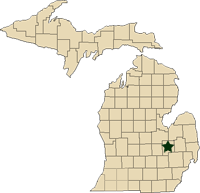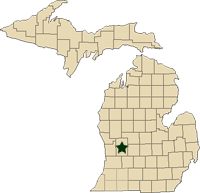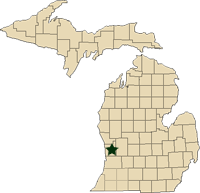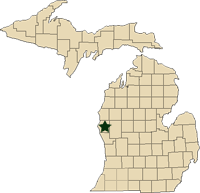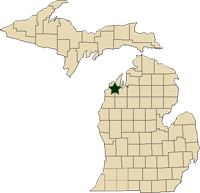Regional reports on Michigan fruit – June 14, 2011
MSU Extension educators’ pest and fruit updates for Michigan.
This week’s regional reports:
- Southwest Michigan - Mark Longstroth, Bill Shane, and Diane Brown-Rytlewski
- Southeast Michigan - Bob Tritten
- Grand Rapids Area Tree Fruit - Amy Irish-Brown and Phil Schwallier
- Grand Rapids Area Small Fruit – Carlos García-Salazar
- West Central Michigan - Mira Danilovich
- Northwest Michigan - Nikki Rothwell, Duke Elsner, and Erin Lizotte
Southwest Michigan – Mark Longstroth, Bill Shane, and Diane Brown-Rytlewski, Michigan State University Extension
|
Last week began hot with highs near 90. Winds late Wednesday (June 8) gusted up to 40 miles per hour in higher sites. Thursday brought cooler conditions with highs near 70. Rains on Thursday and Friday brought between an inch and a half of rain. The rain and cooler temperatures moderated the plant water stress we saw at the beginning of the month. The top soil is drying out. Soil temperatures are in the mid-60s. We are close to normal fruit development. Check for the closest weather station at Enviro-weather.
| Southwest Michigan Growing Degree Day Totals from March 1 through June 12 | |||
| Location | GDD 42 | GDD 45 | GDD 50 |
| Bainbridge | 1075 | 888 | 624 |
| Trevor Nichols | 963 | 791 | 546 |
Tree fruit
Plum curculio egglaying is probably finished. Rose chafer are out and feeding in many fruit crops. Codling moth eggs should be hatching and controls need to be on. San Jose scale males are being trapped and we expect crawlers in a week or two. Birds are feeding on ripening cherry fruit. Birds are visual creatures and attack fruit as it changes from green to red or blue. Bird control measures need to be initiated early as the birds start to feed, not after it becomes a habit, to be effective.
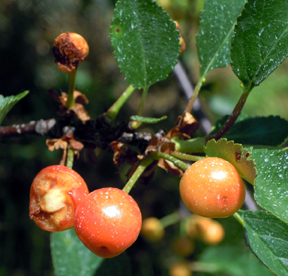
Bird damage to ripening tart cherries. Photo credit: Mark Longstroth, MSUE.
Apricots are over 1.5 inches in diameter.
Peaches are about an inch in diameter. Growers are thinning the smaller fruit. Shoot strikes from oriental fruit moth larvae attacking the tender shoot tips are easy to find in some sites. These larvae will also migrate to new shoot tips. We continue to trap oriental fruit moth in good numbers. Tarnished plant bug may be feeding on the fruit. Growers need to continue to protect against diseases such as peach scab, bacterial spot and powdery mildew. Trunk sprays for borers are typically applied between now and early July.
Sweet cherries are 16 mm in diameter and birds are zeroing in on coloring fruit of early varieties. Bacterial canker symptoms on the fruit (sunken black lesions) are easy to find in both sweet and tart cherries. Leaf symptoms are not as common as fruit symptoms. Sweet cherries become very susceptible to brown rot infection as they ripen. Sweet cherries are also susceptible to cherry leaf spot.
Tart cherries are about 11 mm in diameter. Fruit that is coloring on some trees is larger as the fruit begins final swell and ripening. Some fruit drop is continuing. Bacterial canker symptoms can be found on both fruits and leaves. Cherry leaf spot symptoms have been found in some orchards.
Plums are 18 mm in diameter and the crop is light. Growers should maintain black knot controls until shoot growth ends. Water-soaked, dark fruit spots due to bacterial spot are appearing.
Apples are almost an inch in diameter with some early varieties greater than an inch. Fire blight symptoms, wilting shoots and ooze are common where the disease is established and where the sites are exposed to blowing sand. The disease is serious in several orchards, but neither common nor widespread in the region. We are at the end of primary apple scab season. Growers need to scout their orchards to determine if they have scab leaf lesions. If you have active leaf lesions, maintain fungicide coverage to protect against secondary scab infection. Powdery mildew is a concern on susceptible varieties.
We are still catching codling moth in good numbers and codling moth biofix for the region ranges from June 1-3. We are 230 to 250 GDD base 50 after biofix and egg hatch is beginning. Tarnished plant bug may be feeding on the fruit. Aphids and leafrollers can be found in many orchards. Few obliquebanded leafrollers were caught in southwest Michigan last week, and we have not set biofix. Wood boring beetles were reported attacking young apple trees in Hillsdale County.
Pear fruit are almost an inch in diameter. Pear psylla adults and nymphs can be found. First generation codling moth is generally not a concern in pears, but may be a problem in some orchards.
Small fruit
Grape bloom began last week. Full bloom for Concord was recorded as June 8. June 6 is the five-year average for Concord bloom, June 8 is the 10-year average and June 10 is the average of the last 41 years that National Grape has recorded Concord bloom date. Grape berry moth larvae have been observed feeding on grape clusters and bloom. Other insect pests includerose chafer, grape leafhopper (Labrusca grapes) and potato leafhopper (Vinifera and hybrid grapes) in low numbers. There is no need to apply insecticides to control these pests until after bloom ends
Grape berry moth is being trapped at high numbers at some locations. We set biofix for grape berry moth May 30-31 in Berrien County and June 1-2 in Van Buren County. Bloom sprays should focus on disease control. Phomopsis symptoms are common. Growers should continue to apply fungicides to protect developing fruit and the cluster rachis. Both fruit and rachis infections remain latent until near harvest. Black rot and downy mildew symptoms have been observed and growers should protect against these diseases in the early post bloom period. Powdery mildew symptoms have not been observed yet.
Blueberry fruit are 10 to 12 mm in diameter and shoot growth continues in most fields. Growers need to protect against anthracnose fruit rot and fruitworms. Both cranberry fruitworm and cherry fruitworm were biofixed in late May or early June and controls should be on the fruit. Fruitworm-infested fruit were found last Friday (June 10). Aphids are becoming easy to find. We are also seeing small blue fruit in some fields that has not dropped from the bush. It is unclear whether this fruit is diseased, a result of winter injury or just poor pollination.
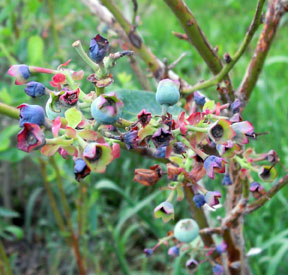
Small blue blueberry fruit. Photo credit: Mark Longstroth, MSUE.
Strawberry harvest is well underway. Last week’s hot weather moved the fruit quickly and also caused portions of some fields to collapse from the stress. These fields showed symptoms of black root rot and looked fine as long as water was abundant and the weather was cool. In the hot weather, the diseased root system could not supply enough water to the leaves and ripening fruit. Because of the wet conditions this spring, slugs are a problem in some fields.
In brambles, bloom in summer bearing raspberries is ending. Bloom in blackberries continues. Growers should be scouting for leafrollers, leafhoppers and rose chafer. Fungicides to reduce fruit rots and cane diseases are worthwhile. Diseases noted while scouting include cane blight, spur blight and raspberry leaf spot. Primocanes in fall bearing raspberries are over two feet tall.
Cranberries are blooming.
Southeast Michigan – Bob Tritten, Michigan State University Extension
|
Weather
We have had quite a swing of temperatures over the last week, with very warm temperatures mid-last week and then cooling over the weekend (June 11-12). While rain showers moved through the region over the weekend, it does not appear as if they brought significant moisture. Soil moisture supplies are less than adequate at most farms across the region. I am particularly concerned about newly planted tree fruits and small fruits, as I am starting to see signs of drought stress in both. At some strawberry farms, large cracks have developed in the soil down the planting row that is causing plants to dry out and die. I encourage growers of all fruit crops, but particularly strawberries, to keep an eye on new plantings to be sure soil moisture is adequate.
The season is still running behind normal in terms of degree day totals, but we are catching up to be more normal. However, even though strawberry harvest started a week later than normal at most farms, sweet cherries appear to be ready for harvest about the normal date of July 4.
| Southeast Michigan Growing Degree Day Totals for March 1 to June 13 | |||
| Location | GDD42 | GDD45 | GDD50 |
| Commerce (Oakland) | 1020 | 846 | 597 |
| Emmett (St Clair) | 965 | 795 | 554 |
| Flint (Genesee) | 1036 | 860 | 610 |
| Lapeer (Lapeer) | 1025 | 852 | 607 |
| Petersburg (Monroe) | 1121 | 932 | 660 |
| Pigeon (Huron) | 873 | 712 | 488 |
| Romeo (Macomb) | 984 | 813 | 571 |
Tree fruits
Apple drop is pretty well complete across the region. Apples are at about 20 to 24 mm in size. Most apple blocks have thinned down to a point where growers are fairly comfortable with the crop they have. All blocks appear that they will require some hand thinning as we move through the summer as there are individual trees and limbs on trees that are carrying too many fruit. The thinning window is now closed across most of the region, with the exception of the Thumb where growers still have about three to five days left to make a final thinner application. There are still a few varieties that have a very heavy fruit set, and these would include Gala, Fuji and a few blocks of Golden Delicious. With the length time that most apples were in bloom with good weather and good honey bee activity, I am surprised that we have had so much June drop. Looking back at the weather at the time that apples were toward the end of full bloom, I think that the combination of excessive rain and low light levels all contributed to heavy fruit drop and resulted in a mediocre fruit set.
The complex of insects in apples is changing as we are moving from spring to more of a summer pattern. While there are some blocks that have heavy plum curculio damage, I am not seeing any new egglaying stings and I think they are pretty well done for the season. The same holds true for tarnished plant bug. Some blocks are seeing very high levels of codling moth flight in the range of 20 to 30 per trap. Most growers biofixed for codling moth on May 30, however, we still have some farms that have not caught enough moths to biofix. The best I can describe codling moth activity this year is that it is all over the board. There has not been any egg hatch.
Oriental fruit moth trap catches are generally low. Obliquebanded leafroller trap catches are now on the rise for the early summer adult flight. I am seeing a few large obliquebanded leafroller larvae. Aphids are generally under control in apples. I am starting to see more woolly apple aphid adults be more visible on the trunks of trees. I have just seen one block that has woolly apple aphids congregating in small clusters.
Potato leafhopper adults are being seen commonly, although their numbers are low. Spotted tentiform leafminers remain in the mines. San Jose scale crawlers are just starting to be seen at a few farms. European red mites are visible at most farms; however their numbers are very low. One odd thing about European red mites this year is that they appear to be much smaller in size for this time of the typical season. There are a lot of new predators that are being seen this week, including lady beetles, brown lace wings, thrips and stink bugs. I continue to see a few Amblyseius fallacis and Stethorus beetles. I am also starting to see a few minute pirate bugs. In some apple blocks, there is not enough “food” for predators and they are moving out of orchards and into ground covers and wood lots for a short time.
I caught a few apple scab spores at both of the apple scab spore trapping stations from rainfall on Saturday night (June 11). We are still in primary apple scab season. Rainfall is expected on Wednesday night (June 15) and Thursday, and I do not anticipate finding any apple scab spores, but I just have to let things happen as they will. I continue to see a fair amount of apple scab around the region. I am seeing scab lesions on both the top and bottom of leaves and some on the fruit. I characterize scab as being present in most orchards, but at low levels for most. I continue to see the signs of frog eye leaf spot or black rot symptoms on foliage, as well as powdery mildew. However, neither of these diseases seems to be increasing at this time. Fire blight continues to show up in just a few limited number of blocks where blight has been a problem in the past. I am not seeing any severe epidemic this year for fire blight.
Pears are at 16 to 22 mm. I am starting to see a few more pear psylla adults and a few more eggs, however, overall their numbers are very low this year.
Peaches are at 22 to 24 mm in size and not at pit hardening. I have seen a number of peach blocks where the leaves are in tough shape, with a fair amount of leaf drop occurring. In some blocks, I attribute this to bacterial spot infections, others may be a result of a little bit too much copper applied this spring, and others still a bit of a mystery as to why foliage is yellowing and sparse. I am starting to see this turnaround fairly well in most blocks.
Growers are thinning peaches heavily at this point in time. Where the foliage symptoms that I described earlier are present, I encourage growers to thin a bit more heavily. I am starting to see two-spotted spider mite adults in more peach blocks; their numbers are generally very low at this time. I also see low numbers of green peach aphid around in many blocks of peaches.
Sweet cherries are around 13 mm with quite a broad spread of fruit sizes. Last week, I reported a fair amount of fruit that was turning red. Much of this red fruit has dropped to the orchard floor and in other blocks the reddening continues. I think that most of this fruit is going to drop. There are a few blocks with cherry leaf spot symptoms. I caught a few cherry fruit flies in some spotted wing Drosophila traps in the past week.
Tart cherries are at 11 mm in size.
Plums are at 19 mm in size for Stanley types and Japanese plums are mostly at 18 to 20 mm in size. I continue to see new infections from black knot disease.
Small fruits
Strawberry harvest is underway across the region. Farms in the southern part of the region are picking consistently everyday while farms in the north are getting picked out fairly quickly and may close for ripening for a day or two. I continue to see some strawberry plantings where slug populations are high. I started to see some slug damage in the last few days as berries are beginning to ripen. I am also seeing some spots where birds are also pecking at ripening fruit. Strawberry leaf spot symptoms continue to be seen in fairly low levels. I am a bit concerned that I see some strawberries ripening that are smaller than what I anticipate and may be a problem with berry size in about a week to 10 days. I am also concerned that several strawberry fields are on the dry side at this time.
Raspberries are in full bloom for summer fruiting types. Fall bearing raspberries have about 24 to 30 inches of new growth. I continue to see more farms that have low levels of raspberry saw fly injury.
Blueberries are 6 to 11 mm in size.
Grapes are at full bloom for Concord types and French hybrids are about four to five days away from bloom. We have about 3 feet of growth in Concord types. I am starting to see grape berry moth larvae feeding in clusters of Concord grapes.
Grand Rapids Area Tree Fruit– Amy Irish-Brown and Phil Schwallier, Michigan State University Extension
|
Tree fruit growth stages
Degree days have remained at near normal averages for the first week of June. All Grand Rapids area Enviro-weather stations are reporting similar numbers. The totals for the Sparta station are 1018 base 42, 838 base 45, and 585 base 50. All but the very latest blooming apple cultivars have moved out of the time when chemical thinners can be expected to work. Apple set is good and sized at 15 to 30 mm, depending on variety and site. There were some light rains June 9-10, but soils are still on the dry side. Growers with trickle irrigation should consider starting their systems. Newly planted trees need watering, too.
Tree fruit diseases
Apple scab. There were some light rains that moved through the area June 9-10 that released only one spore per rod on June 9 and zero on June 10. It is likely that primary scab season is over with the June 9 rain, but monitoring for spores will continue through another rain or two before it will become official. Growers should be carefully scouting for any primary scab that might yet show up from the infections in late May. There is some scab here and there and it’s most likely from the heavy infections that occurred in mid-May.
Fire blight. Still very little blossom blight symptoms are showing up. There are some shoot blight symptoms in problem blocks with active cankers. Continue to monitor problem blocks for fire blight and remove it if feasible.
Powdery mildew is really starting to show up in some blocks. Continue to protect new shoots until terminal bud set in susceptible varieties.
Summer diseases in apple. The model on the Enviro-Weather website indicates that there are several hours of wetting yet needed before summer disease fungicides need to be added to the tank. This model can be very helpful in determining when to start adding summer disease fungicides to your cover sprays.
Tree fruit insects
New plum curculio damage could still be found late last week, but seems to be quieting down this week.
Codling moth biofix for the Grand Rapids area was set for May 30. As of June 14 at midnight, 257 DD base 50 have been accumulated, which indicates that early egg hatch for codling moth should be starting.
Obliquebanded leafroller larvae and pupae can be found in apple terminals in normal or lower than normal numbers. Adult obliquebanded leafrollers have started flying sporadically. Controls that target newly hatching obliquebanded leafroller larvae are 10 to 14 days away at least.
European red mite nymphs and some new adults can be found.
All aphid species seem to be increasing week to week, including green apple aphid, green peach aphids and black cherry aphids. Rosy apple aphids are lessening as they move to other host plants.
Spotted tentiform leafminer tissue feeders are present in normal to below normal numbers and they are past the best timing for sprays to be effective.
White apple leafhopper nymphs are present in normal numbers. Adults should be found soon.
Potato Leafhopper adults can be found.
Dogwood borer in apple has been flying in very light numbers for the past two weeks. Trunk sprays for dogwood borer in apples should be targeted for peak adult flight, which is usually the first week of July.
Oriental fruit moth continues to fly in normal numbers for this region. A biofix was set for the general Grand Rapids area for May 12 and 592 DD base 45 have been accumulated, which indicates egg hatch should be winding down and is predicted to be over by the end of the week. Growers should be basing their need for oriental fruit moth cover sprays on traps in their orchards.
American plum borer adult flight has been on the high side in peaches. Lesser peach tree borer is just beginning to fly. Trunk sprays for stone fruits should be started by the end of next week for them to be the most effective for the whole season of borer egglaying.
Grand Rapids Area Small Fruit– Carlos García-Salazar, Michigan State University Extension
|
Weather conditions have fluctuated during the last seven days. There were days with temperatures that reached the 90s, but they returned to the low 70s. In general, the maximum temperatures were on average 73°F and minimum temperatures averaging 56°F. Rain, on the other hand, has been sporadic, with a maximum accumulation of 0.48 inches. So far, growing degree-day accumulation in west central Michigan ranges from 998 to 1013 (base 42°F) and 558 to 584 (base 50°F).
Raspberries are in full development, summer raspberries are in the green fruit stage and fall raspberries are in the flower bud stage. We are seeing problems related with cane borers and foliar feeders and tarnished plant bugs. The most common cane borer observed is the redneck cane borer (Photo 1), which causes cane collapse if uncontrolled. Problems associated with foliar feeders are caused by the raspberry sawfly (Photo 2). These problems can be controlled with some of the recommended insecticides. For a complete list of products recommended, please follow the MSU Extension Bulletin E-154, Michigan Fruit Management Guide.
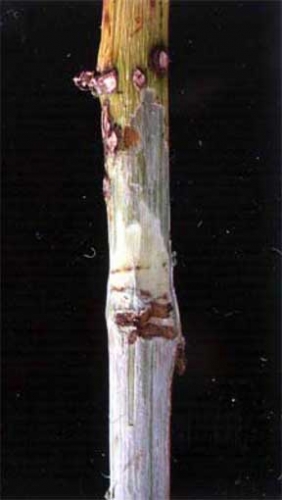
Photo 1. Damage caused by the redneck cane borer in raspberries. Photo credit: Pam Fisher, OMAFRA, Can.
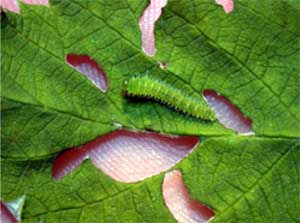
Photo 2. Damage by raspberry sawfly in primo canes. Photo credit: Phil Pellitteri, UW-Madison.
Early season and day-neutral varieties of strawberries are in the first harvest. Up-Picks are open in Allegan and Ottawa County. No major problems with insects or diseases have been observed.
Blueberries are in the green fruit stage. Again, most problems are associated with winter damage. Right now, this damage is recognizable because affected bushes are showing shoots with abundant small fruits, but few or no leaves at all. Fruits in those canes will turn blue and will not reach maturity. In fact, shoots showing these conditions will collapse later during the summer. They should be pruned to prevent cankers later on.
Regarding insect problems, we are finding fruit damage caused by cherry fruitworm and newly hatched cranberry fruitworm. Growers that missed the first application at the beginning of petal fall will start seeing some fruit damage. Shoot strikes are minimal, except in fields where mummy berry control was deficient. In addition, fields with mummy berry problems are already showing fruit damage. When cut in half, affected green fruits are showing the characteristic white fungal growth. This is the right time to conduct the first evaluation of the effectiveness of your mummy berry control program.
This week, we are conducting our fourth Twilight Meeting. The meeting will be on June 16 at A & L Farms, 11901 144th Avenue, West Olive (1/2 mile North of M-45). This Blueberry IPM meeting featuresMSU’s Department of Plant Pathology’s Annemiek Schilder and MSU’s Department of Entomology’s Rufus Isaacs. Schilder will focus on disease control after bloom and through harvest, including mid-season disease control, fruit rots, canker diseases and virus diseases, as well as effective fungicide use. Isaacs will focus on insect control, including fruitworms, blueberry maggot, an update on spotted wing Drosophila and effective insecticide use.
There is a $10 charge for these meetings, which include dinner and handout materials. Growers need to call the MSU Extension office in the county hosting the meeting they plan to attend so that meal arrangements can be made. Please RSVP by contactingJudy Hanson at 616-994-4548.
West Central Michigan – Mira Danilovich, Michigan State University Extension
|
Weather and crop development
This season continues to amaze us. Just a week ago both people and plants were gasping for some cool air in the sweltering heat. From Wednesday (June 8) on, we find ourselves at the opposite side of the pendulum swing. It is downright cold. During this cool-down, low temperatures were generally into the 40s with the exception of Ludington, where we had one night with 52 degrees. The highs were from mid-50s to mid-60s. We did get some much-needed rain. Evapotranspiration was robbing the soil of moisture at a rapid rate. These most recent rains replenished soil moisture in Ludington and Bear Lake, but the Hart area still shows moisture deficit of 0.39 inches. The forecast is calling for slight warmth up ahead. This is great news for apple growers that are getting ready to do some additional apple thinning and fine-tune the blocks with varieties that are hard to thin.
Tree fruit
Sweet cherries are starting to change color. Size is respectable and with recent rains, fruit will gain a few millimeters in circumference. Tart cherries are out of shuck and sizing nicely. Crop outlook looks good. Apples are getting bigger and some varieties are too big to thin. PlumsPeaches are about 20 mm in diameter. are 15 mm in diameter.
West Central Michigan Growing Degree Day Totals Since March 1 As of Sunday, June 12
| Location | DD42 | DD45 | DD50 | Rainfall | |
| Last Week | Since 4/1 | ||||
| Hart | 883 | 720 | 493 | 0.42 | 6.35 |
| Ludington | 838 | 679 | 460 | 0.73 | 7.97 |
| Bear Lake | 863 | 706 | 486 | 0.94 | 9.21 |
Insects
Oriental fruit moth numbers have gone up slightly since last week, averaging three moths per trap. Redbanded leafroller numbers have gone down from 22.5 per trap to six. For Mason County, there has been a 50 percent reduction in American plum borer trap catches. Numbers have gone down from 40 to 21. In Oceana County, the numbers have dropped down more than 50 percent, averaging at 17 moths per trap. Lesser peachtree borers are showing strong flight. The numbers have almost doubled since last week, averaging at 12 moths per trap.
Plum curculio numbers have gone up this week, averaging 2.3 per trap. Scouts are reporting finding various sizes of obliquebanded leafroller larvae in apples and cherries. There are signs of feeding on the fruit. Aphids are present in low to moderate numbers. Rosy apple aphids are showing “partial kill.” Apparently, there were some issues with coverage and application timing. Potato leafhoppers are present in relatively low levels in most fruit except chestnuts. In some chestnut blocks they are near or at the threshold necessitating the application. For further information on potato leafhoppers in chestnut orchards, consult my article on Potato leafhoppers: A menace to chestnut orchards.
Codling moth flight is still very strong. There has been a slight drop in trap catches since last week, but they are still averaging five per trap. Regional biofix for Oceana County was set for May 29 at 273 DD base 50. As of Monday evening (June 13), we have accumulated close to 250 DD50. Regional biofix for Mason County was set for May 30 at 280 DD50. As of Monday evening, there is accumulation of 203 DD50 since biofix. Treatment options for Oceana County have shifted to more traditional pesticides recommended for 250 DD50 post biofix-timing (Guthion, Imidan, Asana, Warrior, Danitol, Decis, Baythroid, Proclame and Garnulovirus). Though exceeding optimum timing for Neonicotinoids and Intrepid, Mason County still has a very narrow window of a day or two to use Assail, Calypso, Clutch (Neonicotinoids) and Intrepid (IGR).
Diseases
The good news is that there was no apple scab spore release and none were found on the rods after the rains this past week, indicating the end of primary. Ludington had two infectious events on June 8 and June 10, resulting in moderate and heavy scab and cherry leaf spot infections. Wetting events in Hart resulted in low cherry leaf spot infection. Rain on June 10 in Bear Lake resulted in moderate apple scab infection and low cherry leaf spot infection. Symptoms of previous infections are present at low levels in some area orchards. Sweet cherries are showing symptoms of bacterial canker on the leaves, spurs and fruit. Now that the fruit is starting to mature and change color, fruit brown rot is getting back into focus. Powdery mildew is a common site throughout the area, particularly in young blocks.
Northwest Michigan – Nikki Rothwell, Duke Elsner, and Erin Lizotte, Michigan State University Extension
|
Weather report
Our temperatures have made a pretty big swing in the past week. We hit daytime temperatures of 94 and 87 degrees on Tuesday (June 7) and Wednesday last week, but on Thursday, temperatures dropped into the 60s. By Saturday (June 11), the daytime high was 54 degrees. The degree day accumulations are still lagging behind our average: 803GDD base 42 and 426 base 50. The strange temperatures also brought some precipitation and unfortunately some hail to the region. As temperatures started to drop on Wednesday, some places had a hard but short rain while others had a fair amount of hail. We received 0.78 inches of rainfall on Saturday.
Crop report
The size of the tart cherry crop is currently under estimation. The Michigan Cherry Committee estimates the crop in northwest to be 110 million pounds while CherrCo estimates the crop size at a slightly higher number of 125 million pounds. The Michigan Cherry Committee estimates the crop in west central to be 52 million pounds, and CherrCo estimates that same crop to be approximately 60 million pounds. Both organizations estimate the southwest crop to be 19 million pounds. The national average estimate for the regulated states is between 235 to 266 million pounds. The sweet cherry crop is lighter than we originally estimated, and we have sustained some hail damage in sweets in blocks around the region. Pro-gibb is going on cherries at this time.
The weather has presented challenges for growers with the extreme hot temperatures followed by the unseasonably cold temperatures. Growers were hesitant to thin in the hot weather, but many did put on some thinners at this time. Other growers that chose not to thin with high temperatures put thinners on Sunday evening and into the morning of Monday (June 13) to take advantage of the 70 degree weather predicted for Monday, Tuesday and Wednesday.
Raspberries are approaching bloom. Strawberries are still blooming but we also have fruit sizing in early varieties.
Pest report
Apple. The apple scab model predicted an infection period in conjunction with the rain on June 11-12. According to the apple scab model on Enviro-weather, 100 percent of overwintering spores have matured and 89 percent have discharged. Many areas of the state have called an end to primary scab, but based on the model, limited rainfall, and continued spore trap catches, we are not calling an end of primary scab in the north quite yet. We have seen symptoms of scab infection in high pressure and unmanaged orchards at this time. As we move into warmer weather and the risk of fruit scab increases (as apples develop), growers should be considering second generation sterol inhibitors (Indar and Inspire Super) or Captan tank-mixed with EBDCs. With the epiphytic infection potential (EIP) over 400 and extreme weather, hail, and tag bloom all present over the past week, fire blight potential was extremely high. Many growers went into the storms with a streptomycin cover, but the few that had isolated hail applied a strep spray directly after the storm. At this time, streptomycin remains the bactericide of choice for controlling fire blight in the northwest.
Spotted tentiform leafminer trap catches continued to drop this week with an average of 52 moths per trap; larvae are present at this time and feeding on leaves. Oriental fruit moth trap catch rebounded this week with 12 moths per trap. Codling moth activity continued for the fourth week in a row with an average of 12 moths per trap, a cumulative trap catch of five moths in one trap location warrants first generation management. Based on trap catch data from the research station, we have set the codling moth biofix at the NWMHRS as May 31 and have accumulated 184 DD50 since. The majority of treatments target egg hatch, a predicted 250 DD50 after sustained catch, growers can track their progression using the codling moth model on Enviro-weather. Keep in mind that codling moth resistance to Guthion is well documented and that moths resistant to Guthion will also be resistant to pyrethroids. Refer to the MSU Extension bulletin E-154 Michigan Fruit Management Guide and the codling moth model for more information on management.
Obliquebanded leafroller larvae continue to develop (up to 1 inch in some locations, but variable sizes are present) and are prevalent in area apple orchards. Widespread obliquebanded leafroller resistance to Guthion and pyrethroids exists in northwest Michigan, so growers should not be applying organophosphate materials or pyrethroids to control this insect this season. In apple, adults obliquebanded leafroller moths are easily trapped with pheromone baited delta traps, and larvae are also relatively easy to locate due to their leaf rolling behavior. At this time of the year, growers should look for larvae in the terminals and evidence such as frass and webbing. Adult obliquebanded leafrollers will likely begin flight in the next two weeks.
Minimalrosy apple aphid activity has been reported. Forest tent caterpillar is present in area orchards, but populations are more moderate than in previous years. Beneficial lady bug larvae and crane flies are out and active.
Cherry. Obliquebanded leafroller activity continues with larvae quickly increasing in size (1 inch this week, although multiple sizes are present and some have begun to pupate). Targeting this overwintering generation is critical in cherry and should be controlled early when they are small and easier to kill; this window is shrinking as the larvae continue to increase in size. An insecticide should be applied if two or more larvae are observed per tree. The materials that target this life stage are Delegate, Belt, Altacor, Voliam flexi, Entrust and Bts. Growers in northwest Michigan should not expect organophosphates or pyrethroids to provide effective control because of insecticide resistance. Obliquebanded leafrollers do not feed internally in fruit, but are problematic as contaminants in tanks at harvest. No adult flight has been observed, but will likely begin in the next two weeks. Those missing this first larvicide application window will have a second management window, though the second larval generation often coincides with harvest and is not ideal for management. Green fruitworm larvae are also present (1 inch when observed this week).
Plum curculio activity is evident in area orchards with crescent shaped egglaying scars easily visible on green fruit. If growers are utilizing insecticides other than the organophosphates (Guthion, Imidan), the traditional treatment timing is petal fall or shuck split, depending on the mode of action. Consult the insecticide label and the MSU Extension Bulletin E-154 Michigan Fruit Management Guide for more information on proper timing. Based on a full bloom biofix of May 21 in Montmorency, we have accumulated 281 DD50 towards the 375 DD50 window for organophosphate application for plum curculio management. First generation American plum borer emergence continues at low levels. Lesser peach tree borer was caught in Enviro-weather station traps for the second week in a row with an average of five per trap. Based on historical trap catch data, we would expect peak trap catches to reach closer to over 20 moths per trap and will reserve trunk sprays for that time. Lesser peach tree borer produces one generation per season with treatment targeting adult flight. Minimal black cherry aphid activity has been reported.
The potential for epidemic levels of cherry leaf spot is a concern this season. Despite some relatively tame leaf spot weather and model predictions, as well as standard management practices, symptoms are present in the orchard at this time. Cherry leaf spot overwinters in fallen leaves on the orchard floor and produces apothecia (sexual spore-bearing structures) in the spring. Following infection, acervuli (asexual spore-bearing structures) develop on the underside of the leaf and produce a visible mass of asexual spores called conidia (these are currently visible). Spores are dispersed from leaf to leaf by wind or rain and this secondary infection cycle can be repeated several times within a season, depending on conditions. In the past, when we have seen symptoms of cherry leaf spot this early in the year, it quickly rises to epidemic levels and causes premature defoliation and reduced fruit ripening. This year, the symptoms are throughout the tree canopy and we hypothesize that this infection is due to fungicide wash-off rather than a coverage issues. Refer to the article Cherry leaf spot observed on June 1 for more information.
Cherry leaf spot is resistant to sterol inhibitor fungicides (Indar, Elite, Orbit) in all the major fruit producing areas of Michigan. As orchards move into first cover, full covers of products that contain strobilurin fungicides (Gem, Pristine, Adament) are recommended as they provide excellent leaf spot and powdery mildew control. Remember to alternate the use of fungicide classes and tank-mix with broad spectrum fungicides during the season to manage against resistance development.
With the isolated hail damage in the area, American brown rot is a concern (particularly in sweet cherries), and mummies are sporulating at this time providing inoculum. Hopefully, damaged cherries will drop off over the next days. Growers should be cognizant about controlling American brown rot with damaged fruit in the orchard. Spur death caused by European brown rot and bacterial canker has been reported. Canker symptoms are also present on sweet cherry leaves, particularly in areas with leaf damage caused by high winds. Unfortunately, no control options will work against bacterial canker or European brown rot at this time. Lastly, the early symptoms of powdery mildew are also becoming visible. Before the mildew fungus become visible, leaf margins cup indicating the presence of an infection. The fungus itself will likely become visible over the next week and is most often found on new leaf tissue.
Forest tent caterpillar is arriving in area orchards, but populations appear to be more moderate than in previous years. Beneficial lady bug larvae and crane flies are out and active.
Wine grapes
Recent weather conditions favored rapid shoot growth. Suckering needs to be finished soon or it will get quite difficult to break off shoots and pull them from the canopy. The crop looks good with many three cluster shoots in Riesling vines at the Northwest Station.
There have been reports of significant grape berry moth trap catch on Old Mission Peninsula. Potato leafhopper, although present in the area for some time, has not been much of a concern in vineyards to this time. Rose chafer adults appeared in the area over the weekend and will likely be found in all vineyards soon. It is too soon to speculate on the level of rose chafer populations; they can often be tolerated at low to medium numbers. A sample of grape plume moth larvae was brought in last week. These are small, bright green caterpillars with a few long hairs. They fold leaves slightly with silk and feed in irregular patterns on the leaf surface. In every case of this insect I have personally seen, the level of injury is very minor. I have seen just a few galls of the grape tumid gallmaker fly this spring – another uncommon and usually insignificant insect.
There was still no sign of powdery mildew on sprayed vines at the Northwest Station as of June 10. Even if vineyards look clean at this point, care should be taken to protect from infection during the critical pre-bloom and bloom stages ahead.



 Print
Print Email
Email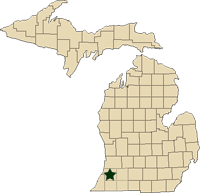 Southwest Michigan
Southwest Michigan